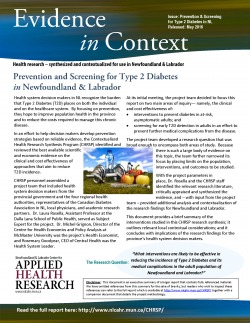New CHRSP Study on Preventing Type 2 Diabetes
Jun 7th, 2016

New CHRSP Study on Preventing Type 2 Diabetes
The Research Question for this study was: "What interventions are likely to be effective in reducing the incidence of Type 2 Diabetes and its medical complications in the adult population of Newfoundland and Labrador?"
CHRSP hosts a dissemination event (live meeting and webinar) to launch this report on June 8, 2016 at the NLCAHR Boardroom with Dr. Laura Rosella, our Subject Expert for this study, Dr. Michel Grignon, our Health Economist for the report, and the Project Lead Sarah Mackey presenting a detailed overview of the project findings.
Key findings from our study include:
- At present, there is an insufficient amount of high-quality evidence on the long-term clinical benefits and potential harms of screening for T2D. The limited evidence that is available showed no evidence of improved mortality through screening for T2D, either in the general population or in high-risk populations after 10 years of follow-up.
- Overall, more robust evidence is needed to confidently evaluate the cost-effectiveness of screening interventions for T2D. In the limited studies available, there was some evidence to suggest that targeted opportunistic screening to detect and manage diabetes among high-risk patients (i.e., patients with obesity and/or with high blood pressure) may be either cost-saving or cost less than $6,000 USD per quality-adjusted life year (QALY) gained. However, it should be noted that there was disagreement between studies on the range of cost.
- Universal population screening of all adults aged at or over 45 years compared with no screening was not shown to be cost-effective at all, with a predicted incremental cost-effectiveness ratio (ICER) of close to CAD$200,000.
- Evidence shows that some oral anti-diabetic drug classes and some other drug classes can effectively prevent the onset of T2D in specific at-risk populations. The authors describe these populations differently: as hypertensive, as high risk, as pre-diabetic, as having at least one cardiovascular disease or as having one cardiovascular disease risk). Other drug classes had no significant preventive effect. Additionally, some drug classes are more effective for promoting regression to normoglycemia than for reducing T2D incidence, depending on the individual’s risk profile.
- Good quality evidence shows that many effective lifestyle interventions (that promote modest weight loss through improved diet and/or increase physical activity) can decrease the incidence of T2D in both the short and long-term. Improvements in blood pressure, triglycerides, weight, BMI and waist circumference were also commonly reported. A key factor in the success of combination lifestyle interventions is adherence to lifestyle changes.
- Most preventive interventions are considered cost-effective, with ICER of less than $20,000 USD per QALY.
- There are a number of heterogeneous strategies that prevent T2D. The effectiveness of these interventions appears to be dependent on age, weight loss, and an individual’s risk profile, among other factors. There is insufficient evidence to comment on the effectiveness of mixed interventions on cardiovascular outcomes or on all-cause morbidity and mortality.